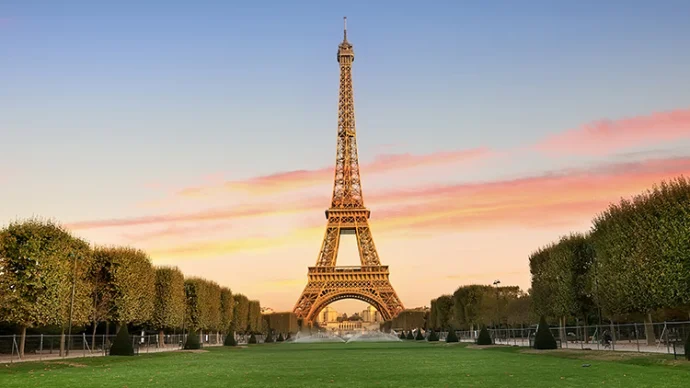
About The Eiffel Tower
The Eiffel Tower (Tour Eiffel) is an imposing iron monument on Paris’ Champ de Mars by the river Seine.
The Eiffel Tower history
The Eiffel Tower was built between 1887 and 1889 based on the design of engineer Gustave Eiffel, after whom the tower was named. In fact Eiffel’s design was chosen out of 107 other proposals as part of a competition to create an iron structure as the entrance way to Paris’ Universal Exhibition World Fair or ‘Exposition Universelle’.
The intention was to mark the centennial of the French Revolution. By Gustave Eiffel’s side were engineers Maurice Koechlin and Emile Nouguier as well as architect Stephen Sauvestre.
Work on the 15 metre foundations began on 26 January 1887 and the Eiffel Tower was inaugurated on 31 March 1889 when Eiffel himself climbed the Tower’s 1,710 steps and planted the French flag at its peak.
At that time, the Eiffel Tower’s 312 metres in height made it the tallest building in the world, only eclipsed in 1929 with the construction of New York’s Chrysler Building.
The Eiffel Tower today
Today the Eiffel Tower is 324 metres tall due to the later addition of antennas, making it the tallest building in Paris and the fifth tallest in the world.
The Eiffel Tower is a tourist hotspot and visitors can climb or use the lifts to reach the first or second floors, the latter of which is 115 metres high. The most expansive views can be found on the Eiffel Tower’s third level at 276 metres, which has its own separate lift from the second floor. A backstage tour is available, which details the workings of the Eiffel Tower and its history.
Every year approximately 7 million visitors climb the Tower, not to mention the millions more who enjoy the wonderful park of Champ de Mars which the tower overlooks. The Eiffel Tower’s success is such that many countries all over the world have replicated the Tower more or less identically to the original one.
Getting to The Eiffel Tower
The Eiffel Tower is located on the Champs de Mars at 5 Avenue Anatole France in the 7th arrondissement of Paris.
Metro and RER lines are ideal public transit solutions in Paris to avoid traffic jams and save precious time during your vacation. If you enter the Eiffel Tower’s address in your smartphone, your GPS navigation app may propose one of the following lines: Bir-Hakeim, Line 6 (Metro) Ecole Militaire, Line 8 (Metro) Etienne Marcel, Line 4 (Metro) Champ de Mars – Tour Eiffel, (RER C line)
You may prefer to travel to the Eiffel Tower by bus. Several lines (42, 82, 87, 69) access the monument, with no fewer than five stops close to the Iron Lady.
If you are travelling from Les Invalides, you are only 1.25 miles from the Eiffel Tower, or about 25 minutes of walking. If you are short on time, the shortest path is to turn left on Rue de l’Université and continue walking straight to the Eiffel Tower.
If you are travelling from Arc de Triomphe, from the Charles de Gaulle Etoile stop, take Metro Line 6 (heading toward “Nation”) and exit at Bir-Hakeim. Allow five minutes on the subway and 10 minutes of walking to get to the Eiffel Tower.
Featured In

Paris Historic Sites
The City of Light has captured the hearts and minds of all who wander through it for centuries. Here's our pick of 10 of the best historic sites to visit while you're there.

France Historic Sites
From towering imposing castles to First World War trenches, ancient Roman ruins to historic Revolutionary sites, France is brimming with relics of its esteemed and turbulent history. Here's our pick of 10 of the very best attractions in the country.

Top Paris Historic Sites
The City of Light has captured the hearts and minds of all who wander through it for centuries. Here's our pick of 10 of the best historic sites to visit while you're there.




















